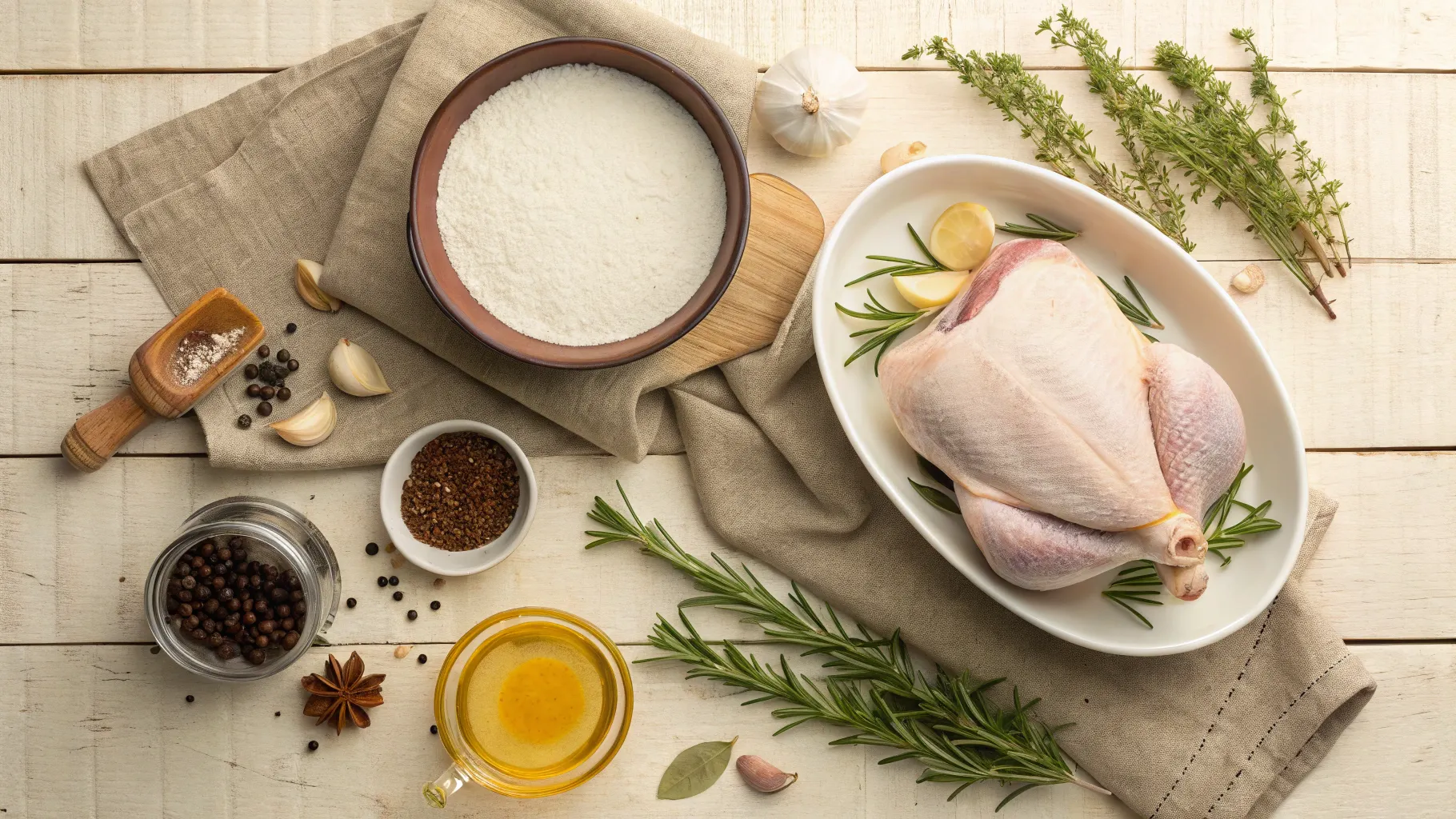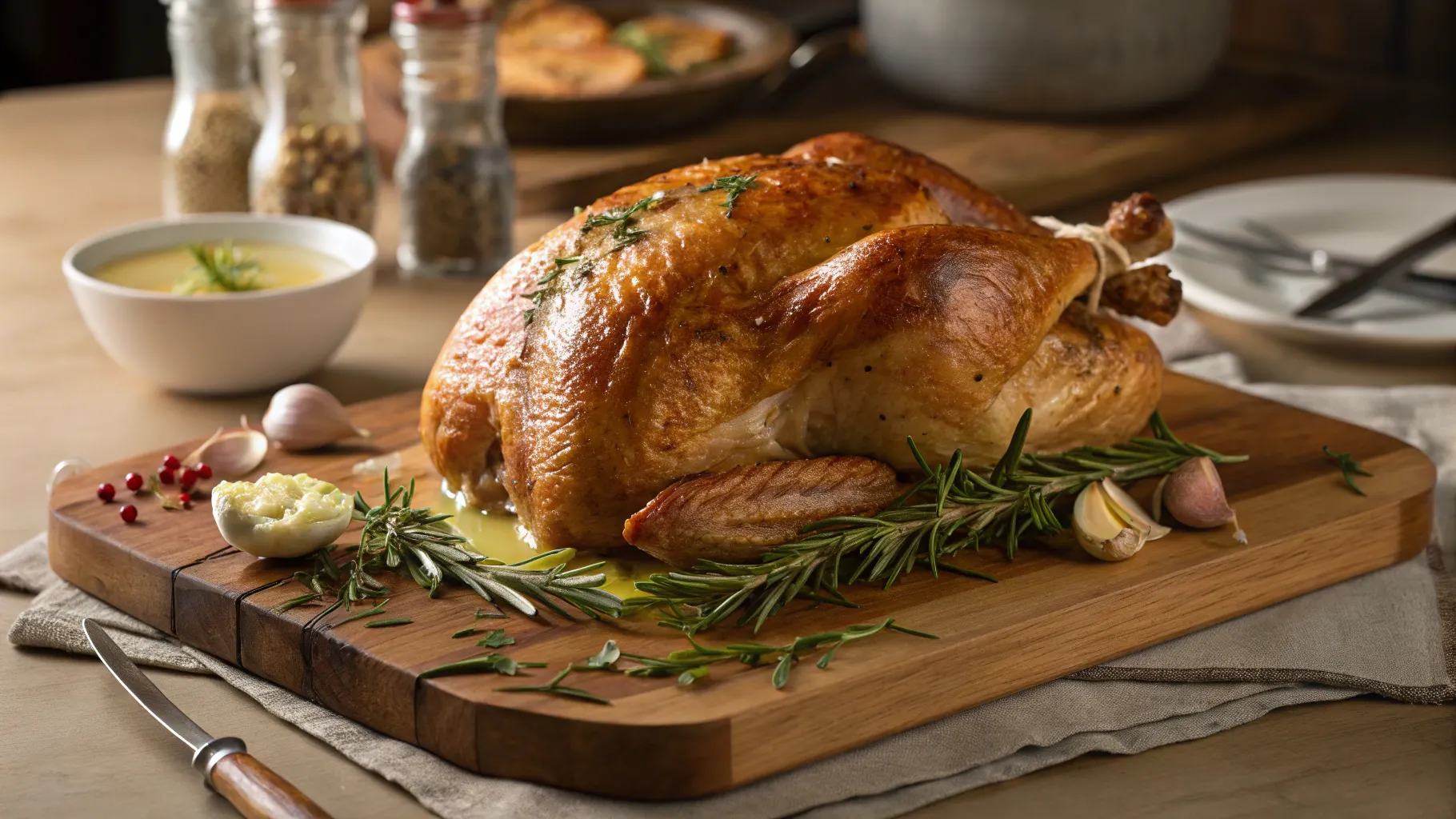Picture this: your kitchen fills with an intoxicating blend of herbs and spices as you pull open the oven door. Golden-brown skin crackles softly while aromatic steam carries whispers of garlic and rosemary throughout your home. Your guests pause mid-conversation, drawn by a scent that promises something extraordinary. This moment transformed my holiday cooking forever, and it all started with discovering the ancient art of buttermilk brining.
For years, I battled the dreaded dry turkey syndrome. Despite following countless recipes and temperature charts, my holiday centerpiece consistently disappointed. Family members smiled politely while secretly reaching for extra gravy to salvage their portions. Everything changed when my neighbor shared her grandmother’s closely guarded secret: buttermilk brining with garlic and rosemary.
Why Buttermilk Brined Turkey with Garlic and Rosemary Changes Everything
Traditional brining methods often produce overly salty results that mask natural flavors. Buttermilk brining revolutionizes this process through gentle acidity that tenderizes meat fibers while infusing complex flavors deep into every muscle strand. Unlike harsh salt brines, buttermilk’s lactic acid works slowly and deliberately, creating incredibly moist meat without overwhelming saltiness.
The Science Behind Buttermilk Brining Success
Your turkey’s transformation begins at the molecular level when buttermilk’s natural acids break down tough protein structures. This process creates space for moisture retention while allowing seasoning compounds to penetrate far beyond surface layers. The result? Every single bite delivers consistent flavor and tenderness.
Buttermilk contains approximately 0.9% lactic acid, creating the perfect pH environment for protein breakdown without causing mushiness. This gentle acidic action works continuously throughout the brining period, ensuring thorough flavor distribution while maintaining meat integrity.
Garlic and Rosemary: The Perfect Flavor Partnership
Fresh garlic releases allicin compounds when crushed, creating robust aromatic intensity that pairs beautifully with rosemary’s pine-like essence. These complementary flavors infuse throughout your turkey during extended brining, creating complex taste layers that develop further during roasting.
Rosemary contains powerful antioxidants including rosmarinic acid and carnosic acid, which help preserve meat quality while adding distinctive Mediterranean notes. Combined with garlic’s sulfur compounds, this herb duo creates an unforgettable flavor profile that elevates simple turkey into gourmet territory.
Complete Buttermilk Brined Turkey Recipe with Garlic and Rosemary
Ingredients You’ll Need for Perfect Buttermilk Brined Turkey
For the Buttermilk Brine

| Ingredient | Amount | Purpose |
|---|---|---|
| Buttermilk | 8 cups | Primary brining liquid |
| Kosher salt | 1 cup | Moisture retention and flavor |
| Brown sugar | ½ cup | Balances acidity, promotes browning |
| Fresh garlic cloves | 12 cloves, smashed | Aromatic depth |
| Fresh rosemary sprigs | 6 large sprigs | Herbal complexity |
| Black peppercorns | 2 tablespoons | Subtle heat and flavor |
| Bay leaves | 4 leaves | Earthy undertones |
| Cold water | 4 cups | Dilutes brine concentration |
For the Turkey and Finishing
| Ingredient | Amount | Purpose |
|---|---|---|
| Whole turkey | 12-14 lbs | Main protein |
| Unsalted butter | 4 tablespoons, softened | Skin browning and flavor |
| Fresh rosemary | 2 tablespoons, minced | Surface seasoning |
| Fresh garlic | 3 cloves, minced | Surface seasoning |
| Olive oil | 2 tablespoons | Skin crisping |
| Black pepper | 1 teaspoon | Final seasoning |
Step-by-Step Buttermilk Brining Process
Preparing Your Buttermilk Brine (24-48 Hours Before Cooking)
Begin by combining buttermilk, kosher salt, and brown sugar in your largest mixing bowl. Whisk vigorously until salt and sugar completely dissolve, creating a smooth, uniform mixture. This foundation determines your brine’s effectiveness, so ensure no granules remain.
Prepare your aromatics by crushing garlic cloves with the flat edge of your knife blade. This releases essential oils immediately, maximizing flavor extraction during brining. Add crushed garlic, fresh rosemary sprigs, peppercorns, and bay leaves to your buttermilk mixture.
Gradually incorporate cold water while stirring continuously. Your finished brine should maintain refrigerator temperature (40°F or below) throughout the entire process to ensure food safety.
Brining Your Turkey for Maximum Flavor
Remove all packaging materials from your turkey, including the neck and giblet package from the body cavity. Pat the entire bird completely dry using paper towels, paying special attention to skin surfaces and cavity areas.
Place your turkey breast-side down in a large, food-safe container or brining bag. Pour the prepared buttermilk brine over the turkey, ensuring complete submersion. If needed, add additional cold buttermilk to cover exposed areas.
Weight down floating portions with a clean plate or bowl to maintain consistent contact between meat and brine. Refrigerate for 24-48 hours, turning the turkey once halfway through the brining period.
Roasting Your Buttermilk Brined Turkey to Perfection
Pre-Roasting Preparation
Remove your turkey from the brine and discard the used liquid. Pat the skin thoroughly dry using clean paper towels – proper drying ensures crispy skin development during roasting.
Preheat your oven to 325°F while preparing the herb butter mixture. Combine softened butter, minced fresh garlic, chopped rosemary, and black pepper in a small bowl. Mix thoroughly until ingredients distribute evenly.
Carefully loosen turkey skin over the breast and thigh areas using your fingers. Spread half the herb butter mixture directly onto the meat beneath the skin, then smooth the remaining mixture over external skin surfaces.
Cooking Temperatures and Times for Buttermilk Brined Turkey
| Turkey Weight | Cooking Time | Internal Temperature |
|---|---|---|
| 10-12 lbs | 2.5-3 hours | 165°F in thickest part |
| 12-14 lbs | 3-3.5 hours | 165°F in thickest part |
| 14-16 lbs | 3.5-4 hours | 165°F in thickest part |
| 16-18 lbs | 4-4.5 hours | 165°F in thickest part |
Position your turkey breast-side up on a roasting rack set inside a heavy-duty roasting pan. This elevation promotes even air circulation while preventing bottom portions from becoming soggy.
Insert a reliable meat thermometer into the thickest part of the thigh, avoiding bone contact. Monitor internal temperature regularly during the final hour of cooking to prevent overcooking.
Pro Tips for Buttermilk Turkey Brining Success
Common Buttermilk Brining Mistakes to Avoid
Never use aluminum containers for brining, as acidic buttermilk can react with the metal, creating off-flavors. Choose food-grade plastic, stainless steel, or glass containers instead.
Avoid over-brining your turkey beyond 72 hours, as extended exposure can create mushy texture rather than tender meat. Monitor timing carefully to achieve optimal results.
Temperature control remains crucial throughout the brining process. Maintain consistent refrigeration to prevent bacterial growth while ensuring proper flavor development.
Make-Ahead Strategies for Holiday Success
Start your brine preparation three days before serving to allow adequate processing time without rushing. This timeline accommodates unexpected delays while ensuring perfect results.
Prepare your herb butter mixture several days in advance, storing it covered in the refrigerator. This allows flavors to meld while reducing last-minute preparation stress.
Frequently Asked Questions About Buttermilk Brined Turkey with Garlic and Rosemary
Can I use store-bought buttermilk for brining turkey? Absolutely! Commercial buttermilk works excellently for brining purposes. Choose full-fat varieties for richer flavor development, and check expiration dates to ensure freshness throughout the brining period.
How long should I brine my turkey in buttermilk for the best results? Optimal brining time ranges from 24-48 hours for most turkey sizes. Smaller birds (under 12 pounds) achieve full flavor penetration in 24 hours, while larger turkeys benefit from extended 48-hour brining.
What’s the difference between buttermilk brined turkey and regular salt-brined turkey? Buttermilk brining produces more complex flavors with subtle tangy notes, while traditional salt brines focus primarily on moisture retention. Buttermilk’s gentle acidity creates more tender texture without excessive saltiness.
Do I need to rinse my turkey after buttermilk brining? Never rinse your brined turkey, as this removes beneficial surface seasonings and can spread bacteria around your kitchen. Simply pat the skin dry with paper towels before proceeding with seasoning and roasting.
Your Path to Holiday Turkey Perfection
This buttermilk brined turkey with garlic and rosemary represents more than just another recipe – it’s your gateway to becoming the confident holiday host you’ve always wanted to be. The science behind buttermilk brining eliminates guesswork while delivering consistently exceptional results that will have your guests requesting your secret technique.
The transformation process begins days before your actual cooking, as buttermilk’s gentle acids work their magic on tough protein fibers. Combined with aromatic garlic and earthy rosemary, this brining method creates layers of flavor that develop beautifully during roasting, resulting in the juiciest, most flavorful turkey you’ve ever served.
Remember that patience remains your greatest ally in this process. Allow adequate time for brining, resist the temptation to peek constantly during roasting, and trust the proven techniques outlined above. Your reward will be a spectacular centerpiece that creates lasting memories around your holiday table.
Ready to transform your holiday cooking forever? Start preparing your buttermilk brine tonight, and experience the confidence that comes from knowing your turkey will be absolutely perfect. Share your results in the comments below – we’d love to hear about your buttermilk brining success story!

